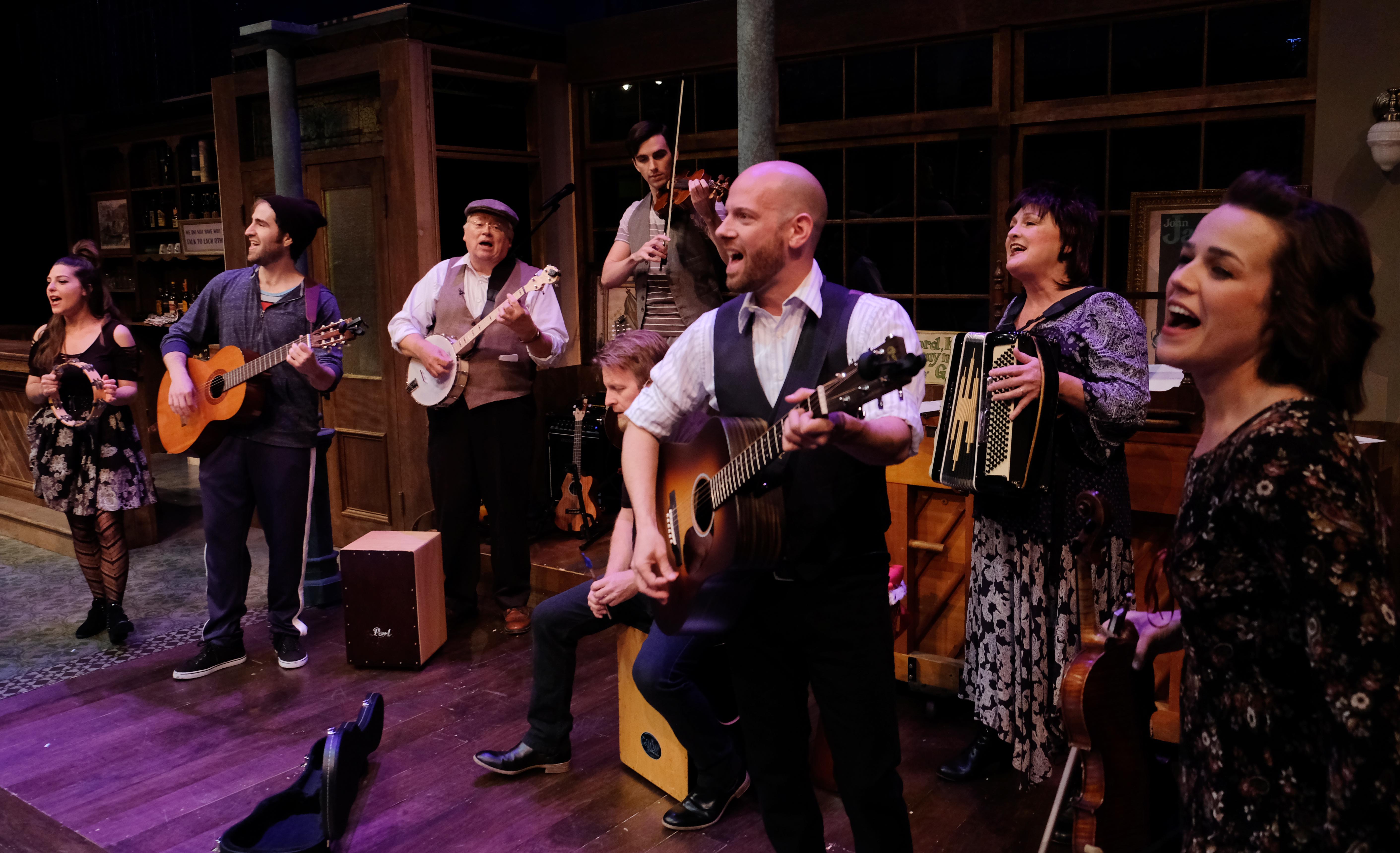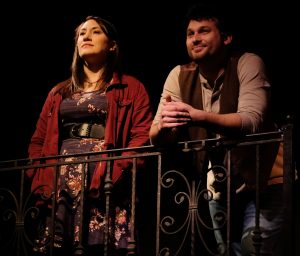Lamb’s Players’ ‘Once’ an Excellent Mosaic Amid Collaborative Direction

Music colors Lamb’s Players Theatre’s excellent ‘Once’ the way human resilience fuels the human experience. Photos by Ken Jacques.
Eight of 11 Tonys in 2012? For this shamelessly commercial, overwrought dogflop of a comedy sketch disguised as a paint-by-numbers love story?
Surely, and effective immediately, the great Republic of Ireland will sever ties with the United States.
And the awards? Nobody named Anthony will ever live ’em down.
Music, including the brilliant Irish folk stuff, is at once as big as the world and as small as your front porch …
On the other hand, that’s why directors have jobs. If the Nederlander guy had been doing his, he might one day have morphed into Kerry Meads, helmer of Lamb’s Players Theatre’s surprisingly and gratefully nice turn at this tale of two unlikely wounded ducks who transform each other through music.
That last word is especially operative here. Music, including the brilliant Irish folk stuff, is at once as big as the world and as small as your front porch — and here, amid its hallowed setting and its actors doubling as its musicians, it sweetly fuels Meads’ excellent mosaic ahead of G. Scott Lacy’s great music direction, guiding audiences through what should become a perfectly good run.
Dublin vacuum repairman and singer-songwriter Guy (as in just a guy) is as musically honest as he is flat out of gas. When we meet him, he’s left his guitar at his feet after one last tune at Billy’s tavern, decrying for all the right reasons his anonymity in the field. He’ll meet up with Girl, a determined young Czech pianist who inundates him with questions about his inspirations.
The songs are at once metaphors for the lives of the many locals who gather at Billy’s to jam, their abandon fielded by guitars, fiddles, drums, a cello, a piano and something that looks for all the world like a cajon. And Guy and Girl? Accordingly, they never stoop to the obvious amid their mutual attraction. Music, it seems, connects them in ways their circumstances cannot — and all’s eventually well with the world.
See? There was a play in there after all. Meads makes that apparent through her acute sense of phrasing in playwright Enda Walsh’s prose and the former’s respect for the music’s role as a character in the show. That’s an enormous concession amid such busy, incisive dialogue, but Meads knows exactly what she’s doing.
… [C]an’t we know something about how one attribute affects the other as her ethnicity (and her music) unfolds?
Still, the show has a blatant shortcoming, all the peskier in that it touches on so many other elements of the story. The Czech Republic, like Ireland, is an absolutely indispensable bastion of art and commerce throughout history — yet Walsh has managed to consign his flagship co-character to the showers. Girl has a fun mom and a spunky daughter, is running from a stormy marriage and sports a mean Mendelssohn in her good piano repertoire; can’t we know something about how one attribute affects the other as her ethnicity (and her music) unfolds?
Guess not.
What we do know is that music yields a resilient heart when given the chance — and Michael Louis Cusimano’s once-brooding Guy is a case in point. Caitie Grady’s “always serious” Girl cracks a smile but once, her severe glower lighting the character’s sum and substance.
I didn’t quite fall for the poor man’s stridor that Manny Fernandes lends his BIlly, but I concede he needs it to distinguish the character from Girl, Guy and Baruska, Girl’s profuse mother (a great Deborah Gilmour Smyth). Everybody else is fine amid their double duty as musicians and their deference to the music’s profundity.
Sean Fannnig’s set has a lived-in look that fuels the players’ itinerant feel, and it carries an especially readable sense of detail (I swear I saw a can of Boddington’s ale along the well-stocked shelves; if that’s true, then prop designer Rachel Hengst is after my heart).

When they’re not busy playing (which is almost never), Girl and Guy (Caitie Grady and Michael Louis Cusimano) commiserate on each other’s lives.
In Nederlander’s defense, our 2014 show was at a disadvantage from the beginning. It was at the Civic Theatre downtown, wherein Broadway San Diego is the anchor tenant — and while that venue certainly has its qualities, it seats close to half a million, far too many spaces to expect this windswept piece to impact.
Lamb’s has gauged the same show for what it is, trading the irksome sketch comportment for Walsh’s intimate, almost Old World frame of mind. All that’s left is to strike up the band — and in more than one respect, this Once takes it from there. Very, very good.
This review is based on the performance of the June 13 matinee. Once runs through August 12 at Lamb’s Players Theatre, 1142 Orange Ave. in Coronado. $58-$78. 619-437-6000, lambsplayers.org.

Martin Jones Westlin, principal at editorial consultancy Words Are Not Enough and La Jolla Village News editor emeritus, has been a theater critic and editor/writer for 25 of his 47 years…
More…
